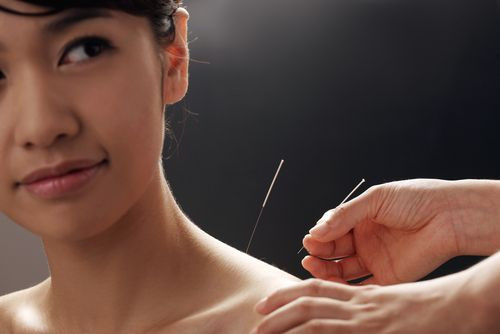Acupuncture, Needling In: Which Symptoms And Sickness Does The Ancient Therapy Treat Most Effectively?

Acupuncture literally means "to puncture with a needle." In practice, this natural healing method involves penetrating the skin with extremely thin needles at strategic points on the body, often performed in combination with herbal treatments. Acupuncture is a key component of Traditional Chinese Medicine, and as such, has been practiced in Asian countries for thousands of years. Worldwide, it has grown in popularity over the past few decades. When do Americans turn to acupuncture for effective treatment?
“Mostly what I treat is pain,” said Enrico Viselli, a licensed acupuncturist who practices in New York City and in Westchester, N.Y. “I do a lot of orthopedic work, because insurance covers it, but I have treated health problems as diverse as infertility and Meniere's syndrome.” This disorder of the inner ear, for which there is no Western cure, causes vertigo — a sensation of spinning — along with hearing loss and ringing in the ear. “I’ve also used acupuncture to get a breach baby to flip over,” Viselli told Medical Daily. “Generally it takes one treatment lasting about 15 minutes, and the baby just flops over.”
Helen K. Pyo, another licensed acupuncturist practicing in New York City, agrees that many of her patients come to her for pain treatment, especially in the areas of the back and neck. “But I treat many conditions,” she said, having worked with a range of compliments, including those normally attended to by an OB-GYN. In particular, she says she specializes in Eastern Dermatology and the treatment of allergies. “I combine acupuncture with herbal medication,” Pyo told Medical Daily. She offers patients a special organic facial, which exfoliates, cleanses, and finally concludes with a special light therapy treatment.
Explanation of the Effects
Generally, Americans visit acupuncturists for pain relief. According to the National Center for Complementary and Alternative Medicine (NCCAM), back pain is the most commonly reported use, followed by joint pain, neck pain, and headache. How effective acupuncture is in treating these conditions has been long debated, and though some scientific studies of the issue have been done, most provide insufficient evidence. However, a few research projects offer some fascinating insights.
A recent study, for instance, found acupuncture helped to alleviate side effects from chemotherapy. Yet fake acupuncture — when a practitioner simulated the procedure — also lessened patient’s negative symptoms, and did so nearly as often as acupuncture. This placebo effect appears to be, in the words of the NCCAM, an “emerging theme in acupuncture research.”
All of which begs the question, exactly how does acupuncture work? A classical Chinese explanation would be this: Just like rivers flowing along the earth, channels of energy run along and through your body, and these meridians, as they are called, irrigate and nourish your tissues. An obstruction in the movement of these energy rivers is equivalent to a dam impeding the flow. Acupuncture needles, then, unblock obstructions and reestablish the regular flow through the meridians. A contemporary explanation of acupuncture’s effectiveness would involve the underlying science: Needling at strategic points along the surface of the body stimulates the nervous system to release chemicals in the muscles, spinal cord, and brain, and in turn, this triggers the release of other chemicals and hormones, all of which affect the experience of pain.
“The whole point of the Chinese medical system in ancient times was prevention,” explained Viselli, who has taught at the Pacific College of Oriental Medicine and the Swedish Institute, both in New York. “The Chinese thought it was much easier to prevent disease as opposed to curing it.” Explaining how the paradigm was opposite that of contemporary Western medicine, he says it made all the difference in the world. “It was an agrarian society, so a doctor would go to each farm and there the owner would say, ‘I need everyone to be well so that we can harvest.’ And the doctor would work with everyone and see how they were doing,” Viselli told Medical Daily. “Chinese doctors were not paid to get you well, but paid to keep you healthy. If they did a good job, they’d be invited back for the harvest feast.”
Changing Landscape
In its review of acupuncture, the World Health Organization said 80 percent of 129 countries surveyed now recognize the use of acupuncture. Worldwide, it is generally safe, and in the U.S., relatively few complications have been reported by patients treated by licensed practitioners. WHO also indicates acupuncture as an effective treatment for more than 50 medical problems and conditions, including addiction, arthritis, depression, dysentery, fatigue, fibromyalgia, insomnia, migraine, pain, pneumonia, sciatica, stress, tooth pain, and vomiting. The greatest champion of the needling practice, China accommodates acupuncture in addition to conventional medicine at every level of its health-care services, with public and private insurance covering both.
While many American patients might want to try or routinely use acupuncture, it is generally considered a complementary medicine and so may not be covered under every insurance plan. Under Obamacare, this may change, though for now it is not entirely clear whether acupuncture is covered. As reported by PBS, section 2706 of the law states insurance companies “shall not discriminate” against any health provider with a state-recognized license.
To many people, this wording suggests alternative medicines, when offered by licensed practitioners, will be reimbursed going forward. “Some insurance companies are giving it a wider berth,” Viselli said. “Like Blue Cross Blue Shield and Cigna. They are more actively using acupuncture as a medical treatment.”
Published by Medicaldaily.com



























